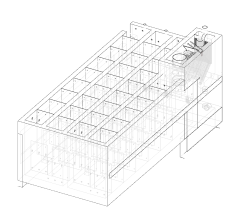The AguaClara Infrastructure Design Engine (AIDE) project team has made great progress this summer on AIDE v2. As discussed in the AIDE Introduction, the team is developing software to rapidly design custom AguaClara water treatment plants over a wide range of flow rates for AguaClara Reach’s (ACR’s) global implementation partners. The project team working this summer focused on three primary components of the AIDE tool - FeatureScript programming of the hydraulic design, Onshape drawings of the plant components, and Python automation which creates plant specifications and documentation.
The FeatureScript team finished writing the supporting fluid functions required for hydraulic calculations. Now, they are working on developing hydraulic design features which perform the necessary calculations for specific plant processes. Several components, including the flocculator and sedimentation tank, are complete. The team is now tackling one of the most complex components, the filter. This design is complex due to the two operating states of the process (filter and backwash), flow distribution challenges associated with the stacked rapid sand filter, and detailed design of the backwash siphon.
The Onshape team completed development of the models for the flocculator, sedimentation tanks, and filter, and is currently finishing the chemical dosing components for 12-60 Liters per second (Lps) AguaClara plants (roughly equivalent to 200-1,000 gallons per minute (gpm)). A new entrance tank designed to reduce splashing and to aid in grit removal was also created based on operational feedback from Agua Para el Pueblo (APP) field staff.
An Onshape model of the flocculator.
A picture of a flocculator from an AguaClara plant in Honduras
The number of flocculator channels increases with the treatment capacity of the plant.
More models will need to be created for smaller (1-5 Lps, 20-80 gpm) and larger (greater than 60 Lps, 1,000 gpm) flow rates. The Onshape team has already developed a new sedimentation tank design for smaller AguaClara plants, as shown below.
Sedimentation tank designs created in Onshape with the capacity to treat 60 Lps (1,000 gpm) on the left and 1 Lps (20 gpm) on the right.
Details of the sedimentation tank design created in Onshape for 1-5 Lps (20-80 gpm) plants.
Using Sphinx, an auto-documentation tool, the Python team translated the AguaClara plant specifications from Spanish (the original language in which the specifications were written) to English. This will make it more efficient for ACR (a US-based nonprofit with primarily English-speaking members) to maintain and update the plant specifications moving forward. Ultimately, the documentation engine will allow AIDE users to seamlessly switch from English to different languages based on user preference. A lightweight Django app is used to accept a preferred target language from the user and an Onshape URL specific to the plant model, and output a PDF version of the specifications for the user. To enable this, a Documenter feature was developed in Onshape which specifies values of variables used in the reStructuredText templates which Sphinx uses to build this documentation.
An excerpt from the Sedimentation Chapter of the plant specifications. Variables shown in red will be replaced by unique values determined through FeatureScript and Onshape, then provided to the AIDE user.
Upcoming work for the team includes end-to-end integration so that users can access the full suite of AguaClara technology. Integration work will begin with smaller pieces, such as incorporating the documentation website into the AIDE model as an Onshape widget. When AIDE is complete, ACR’s website will host a form that collects user-inputs and constraints then directs them to the appropriate Onshape model.
ACR implementation partners, including APP in Honduras and Gram Vikas in India, have recently expressed interest in designs for small-scale plants. In response to these requests, ACR is prioritizing the completion of smaller plant designs within the AIDE tool, while the final version of the tool will include a broader range of flow rates in the AguaClara technology suite.
Stay tuned for progress updates as work continues this fall!
Blog Post Authors: Nicole Wang and Fletcher Chapin






